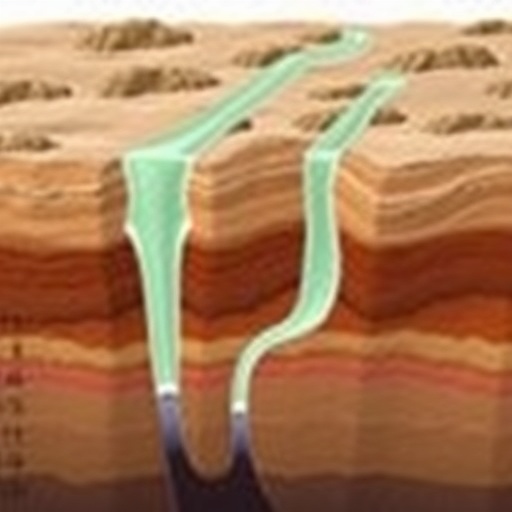Recent advancements in micro-scale two-phase flow experiments have emerged as a focal point in the exploration of residual oil distribution within tight sandstone formations. This complex interaction between oil and water at microscopic levels presents a myriad of challenges and opportunities for enhancing hydrocarbon recovery in increasingly significant reservoirs. The comprehensive study led by Fan et al. offers fresh insights into what governs the distribution of residual oil, revealing critical implications for both scientific understanding and practical applications within the petroleum industry.
Investigating the dynamics of two-phase flow at such a micro-scale requires sophisticated experimental setups and advanced imaging techniques. The researchers embarked on a series of meticulously designed experiments, employing state-of-the-art methodologies to visualize and analyze how oil and water interact within the pore space of tight sandstone. This pioneering approach underscores the importance of understanding the fine details of fluid behavior in subsurface conditions that are often difficult to replicate in larger, conventional studies.
Throughout their experiments, Fan and colleagues observed that the behavior of fluids in tight sandstone is fundamentally different from that in more conventionally permeable rocks. One of the key findings was the significant impact of pore structure on fluid distribution. The researchers noted that smaller pore sizes tend to trap oil, leading to a greater amount of residual oil remaining after the cessation of flow. This phenomenon is crucial, as it indicates that traditional models, which may not account for these nuanced behaviors, could lead to inaccurate assessments of recoverable oil reserves.
In analyzing the interfacial tension between oil and water, the team uncovered important correlations that influence the efficiency of oil recovery techniques. Their experiments demonstrated that variations in temperature, pressure, and saturating conditions can dramatically affect the dynamics of two-phase flow. As a result, optimizing these parameters could potentially enhance oil recovery rates, allowing operators to tap into reservoirs that would otherwise be deemed non-viable due to low output.
Moreover, the role of capillary pressures in controlling the flow of fluids within the porous medium was emphasized throughout their research. The findings suggest that capillary forces play a significant role in determining the connectivity of oil clusters within the rock matrix. By mapping these connections, the research offers a pathway towards developing more refined predictive models for oil extraction strategies, enabling a better understanding of how best to approach challenging reservoirs.
A particular focus of the research was the phenomenon of imbibition—the process through which water is absorbed into a porous medium displacing oil. Imbibition dynamics were thoroughly characterized, revealing insights into how the rate and extent of water absorption can vary dramatically based on the rock and fluid properties involved. This emphasizes the necessity of customizing water flood strategies for particular formations, considering factors that might mitigate or enhance the efficiency of such methods.
Environmental considerations also come into play when discussing the implications of the study. The research offers potential pathways for improving the sustainability of oil recovery methods by identifying more effective techniques that could minimize the environmental footprint associated with hydrocarbon extraction. The challenge of residual oil trapped in tight formations remains a pressing concern, not only for energy production but for reducing the impact of fossil fuel extraction on ecosystems.
The micro-scale exploration presented in this study signals a pivotal shift in how scientists and engineers might tackle the challenges posed by tight sandstone reservoirs. By combining experimental analysis with advanced imaging and modeling techniques, the study exemplifies the synergy between theoretical research and practical application. These efforts could lead to innovative methods that break through existing recovery limitations, particularly in fields where traditional approaches have previously fallen short.
As the study unfolds, it also accentuates the importance of interdisciplinary approaches in addressing complex problems in petroleum engineering. Collaborations among geologists, engineers, and environmental scientists will be vital in transforming the insights derived from such micro-scale studies into actionable strategies that cater to both economic and ecological interests.
The broader implications of the research cannot be overstated. Beyond simply advancing academic knowledge, the work conducted by Fan et al. introduces concepts that could significantly revitalize the industry’s approach to energy extraction. This has real potential not just for improving efficiency but also for shaping policies and practices around resource management in an era increasingly marked by a push towards sustainability.
In conclusion, the innovative research by Fan and his colleagues represents a significant contribution to our understanding of micro-scale two-phase flow and residual oil distribution in tight sandstone. As we continue to seek ways to harness energy resources more effectively, studies such as this provide a foundation upon which future developments can be built. The interplay of oil and water at this level opens doors to new methods of resource extraction, affirming the importance of continued exploration into the intricate behaviors of fluids within our natural reservoirs.
The findings from this research invite further exploration and potential applications within the industry, indicating a dynamic future where micro-scale studies can lead directly to advancements in oil recovery technologies. As science continues to advance, so too does the promise of more efficient and environmentally considerate methods for tapping into the Earth’s reservoirs, ensuring accessible energy for generations to come.
Subject of Research: Micro-scale Two-Phase Flow Experiments and Residual Oil Distribution in Tight Sandstone.
Article Title: Micro-scale Two-Phase Flow Experiments and Residual Oil Distribution in Tight Sandstone.
Article References:
Fan, W., Yu, H., He, S. et al. Micro-scale Two-Phase Flow Experiments and Residual Oil Distribution in Tight Sandstone.
Nat Resour Res (2025). https://doi.org/10.1007/s11053-025-10539-1
Image Credits: AI Generated
DOI: 10.1007/s11053-025-10539-1
Keywords: Two-phase flow, residual oil, tight sandstone, micro-scale experiments, hydrocarbon recovery.




